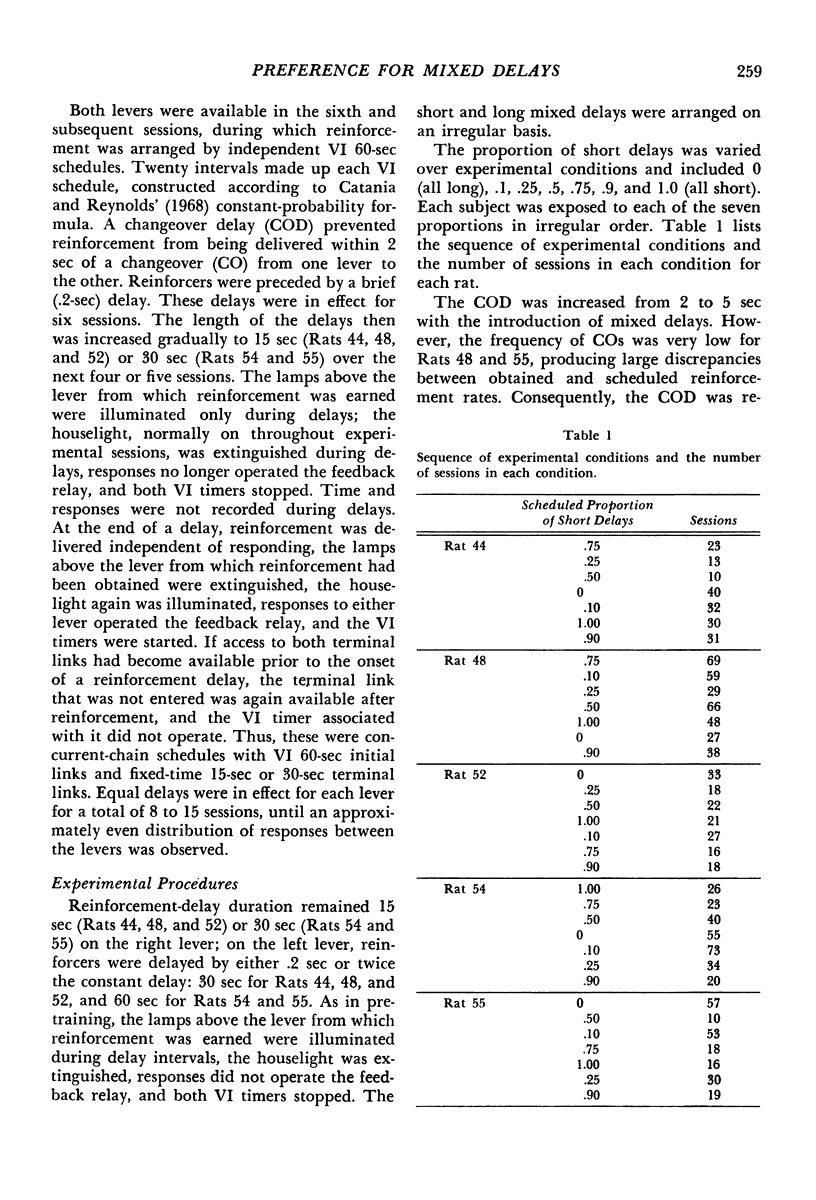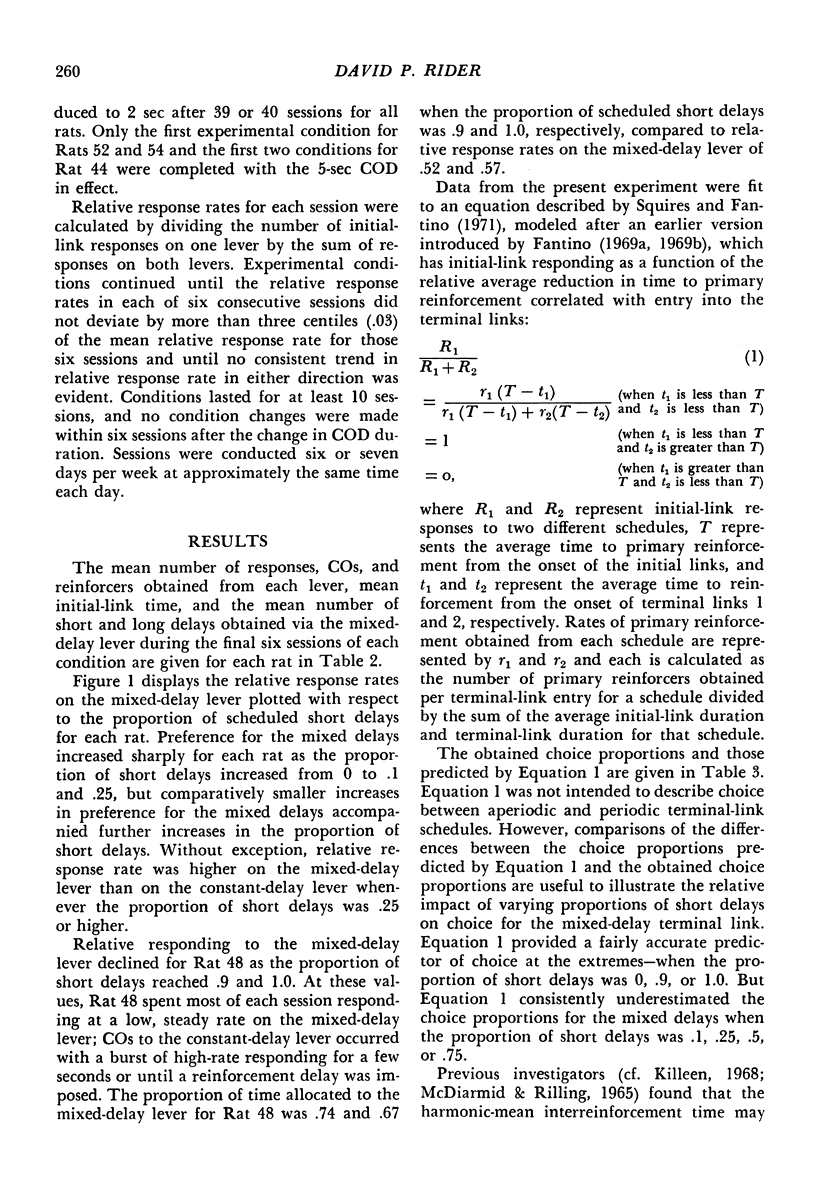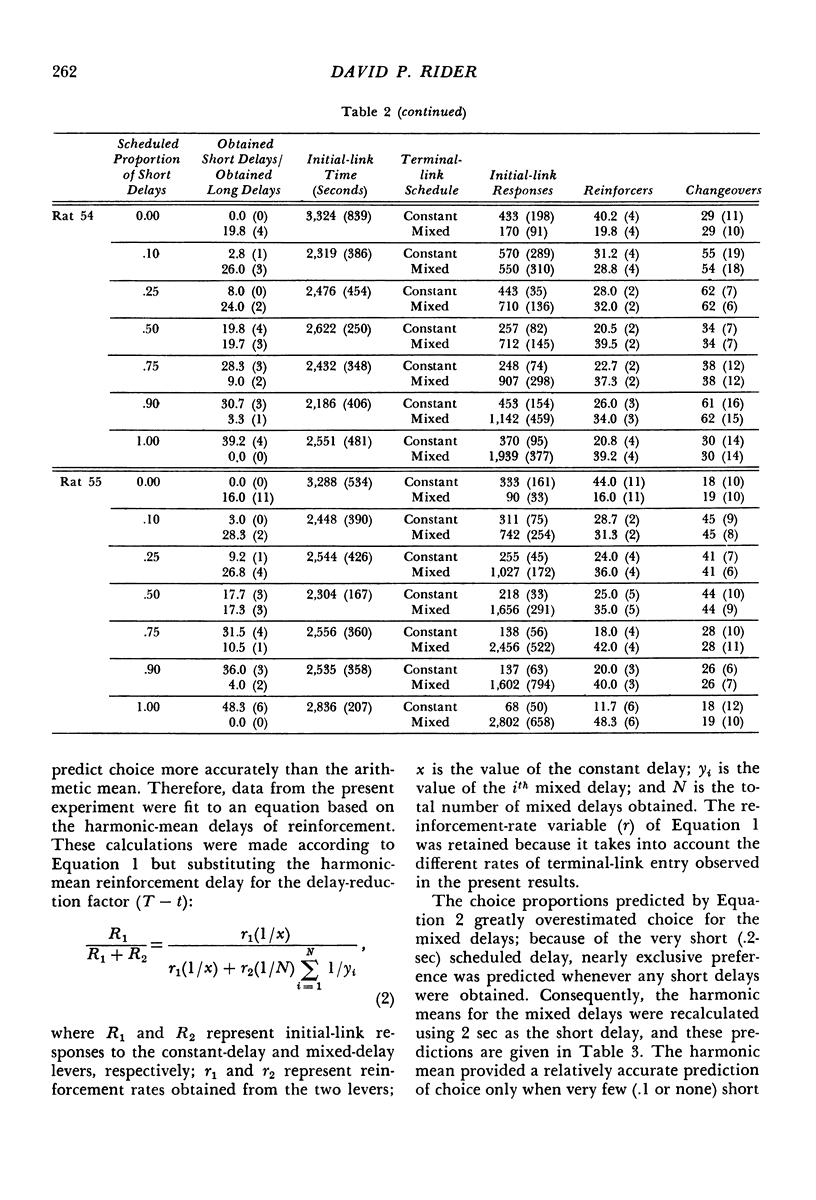Abstract
Preference for mixed versus constant delays of reinforcement was studied with a concurrent-chain procedure. Lever pressing by rats in concurrently available variable-interval 60-second initial links occasionally produced mutually exclusive terminal-link reinforcement delays. A constant delay of reinforcement (either 15 seconds or 30 seconds) composed one terminal link and mixed delays (.2 second and twice the value of the constant delay) were arranged in the other terminal link. The proportion of .2-second delays in the mixed-delay terminal link took on values of 0, .1, .25, .5, .75, .9, and 1.0 over experimental conditions. Based on relative rates of responding in the initial links, preference for the mixed delays was a negatively accelerated function of the proportion of short, mixed delays. Three of five rats preferred the mixed delays to the constant delays when the proportion of short, mixed delays was .1 or higher, and all five rats preferred the mixed delays when the proportion of short, mixed delays was .25 or higher. Neither Squires and Fantino's (1971) delay-reduction model of choice nor a model based on the harmonic mean reinforcement delay provided a close estimate of choice proportions over the range of short-delay proportions studied. The delay-reduction model underestimated choice for the mixed delays at low and intermediate proportions of short delays, and the harmonic-mean-delay model overestimated choice for the mixed delays at intermediate and high proportions of short delays.
Keywords: choice behavior, concurrent chains, delay of reinforcement, schedule preference, lever press, rats
Full text
PDF









Selected References
These references are in PubMed. This may not be the complete list of references from this article.
- Catania A. C., Reynolds G. S. A quantitative analysis of the responding maintained by interval schedules of reinforcement. J Exp Anal Behav. 1968 May;11(3 Suppl):327–383. doi: 10.1901/jeab.1968.11-s327. [DOI] [PMC free article] [PubMed] [Google Scholar]
- Cicerone R. A. Preference for mixed versus constant delay of reinforcement. J Exp Anal Behav. 1976 Mar;25(2):257–261. doi: 10.1901/jeab.1976.25-257. [DOI] [PMC free article] [PubMed] [Google Scholar]
- Davison M. C. Preference for mixed-interval versus fixed-interval schedules. J Exp Anal Behav. 1969 Mar;12(2):247–252. doi: 10.1901/jeab.1969.12-247. [DOI] [PMC free article] [PubMed] [Google Scholar]
- Davison M. C. Preference for mixed-interval versus fixed-interval schedules: number of component intervals. J Exp Anal Behav. 1972 Mar;17(2):169–176. doi: 10.1901/jeab.1972.17-169. [DOI] [PMC free article] [PubMed] [Google Scholar]
- Duncan B., Fantino E. Choice for periodic schedules of reinforcement. J Exp Anal Behav. 1970 Jul;14(1):73–86. doi: 10.1901/jeab.1970.14-73. [DOI] [PMC free article] [PubMed] [Google Scholar]
- Duncan B., Fantino E. The psychological distance to reward. J Exp Anal Behav. 1972 Jul;18(1):23–34. doi: 10.1901/jeab.1972.18-23. [DOI] [PMC free article] [PubMed] [Google Scholar]
- Fantino E. Choice and rate of reinforcement. J Exp Anal Behav. 1969 Sep;12(5):723–730. doi: 10.1901/jeab.1969.12-723. [DOI] [PMC free article] [PubMed] [Google Scholar]
- Fantino E. Preference for mixed- versus fixed-ratio schedules. J Exp Anal Behav. 1967 Jan;10(1):35–43. doi: 10.1901/jeab.1967.10-35. [DOI] [PMC free article] [PubMed] [Google Scholar]
- Green L., Snyderman M. Choice between rewards differing in amount and delay: Toward a choice model of self control. J Exp Anal Behav. 1980 Sep;34(2):135–147. doi: 10.1901/jeab.1980.34-135. [DOI] [PMC free article] [PubMed] [Google Scholar]
- Hursh S. R., Fantino E. Relative delay of reinforcement and choice. J Exp Anal Behav. 1973 May;19(3):437–450. doi: 10.1901/jeab.1973.19-437. [DOI] [PMC free article] [PubMed] [Google Scholar]
- Ito M., Asaki K. Choice behavior of rats in a concurrent-chains schedule: Amount and delay of reinforcement. J Exp Anal Behav. 1982 May;37(3):383–392. doi: 10.1901/jeab.1982.37-383. [DOI] [PMC free article] [PubMed] [Google Scholar]
- Killeen P. On the measurement of reinforcement frequency in the study of preference. J Exp Anal Behav. 1968 May;11(3):263–269. doi: 10.1901/jeab.1968.11-263. [DOI] [PMC free article] [PubMed] [Google Scholar]
- Macewen D. The effects of terminal-link fixed-interval and variable-interval schedules on responding under concurrent chained schedules. J Exp Anal Behav. 1972 Sep;18(2):253–261. doi: 10.1901/jeab.1972.18-253. [DOI] [PMC free article] [PubMed] [Google Scholar]
- Navarick D. J., Fantino E. Transitivity as a property of choice. J Exp Anal Behav. 1972 Nov;18(3):389–401. doi: 10.1901/jeab.1972.18-389. [DOI] [PMC free article] [PubMed] [Google Scholar]
- Sherman J. A., Thomas J. R. Some factors controlling preference between fixed-ratio and variable-ratio schedules of reinforcement. J Exp Anal Behav. 1968 Nov;11(6):689–702. doi: 10.1901/jeab.1968.11-689. [DOI] [PMC free article] [PubMed] [Google Scholar]
- Squires N., Fantino E. A model for choice in simple concurrent and concurrent-chains schedules. J Exp Anal Behav. 1971 Jan;15(1):27–38. doi: 10.1901/jeab.1971.15-27. [DOI] [PMC free article] [PubMed] [Google Scholar]
- Williams B. A., Fantino E. Effects on choice of reinforcement delay and conditioned reinforcement. J Exp Anal Behav. 1978 Jan;29(1):77–86. doi: 10.1901/jeab.1978.29-77. [DOI] [PMC free article] [PubMed] [Google Scholar]


